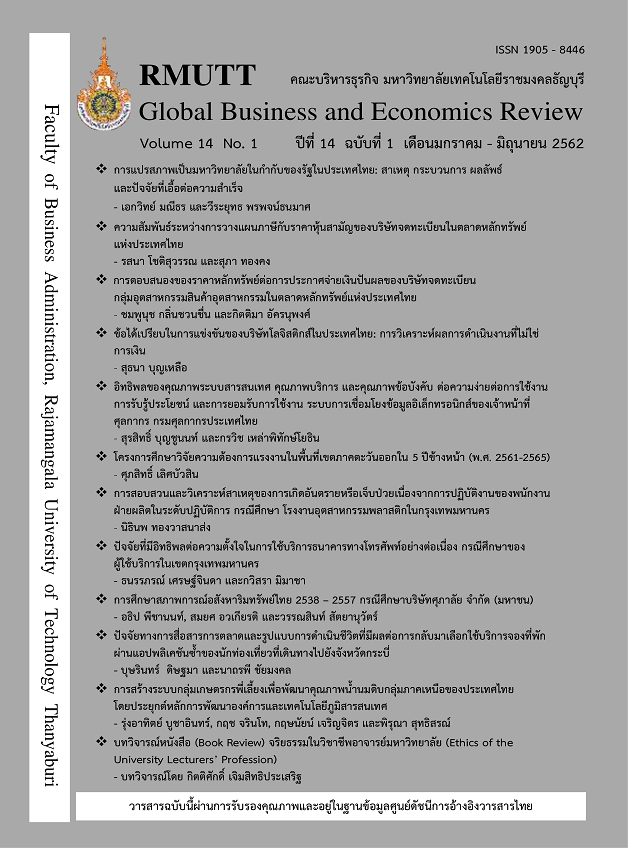THE RELATIONSHIP BETWEEN TAX PLANNING AND STOCK PRICE OF LISTED COMPANIES IN THE STOCK EXCHANGE OF THAILAND
Keywords:
Tax Planning, Effective Tax Rate, Tax to Total Asset Ratio, Tax to Operating Cash Flow RatioAbstract
The purpose for this research was to explore the relationship between tax planning and stock price of listed companies in the Stock Exchange of Thailand (SET). The data were collected from SET’s financial documents and annual reports in the year 2016 of listed companies in SET. The sample comprised listed companies in SET except financial sector companies, companies in revival and rehabilitation as well as companies with operating losses. There were 190 companies containing the complete information that could be used in the study. Levels of tax planning were measured by financial ratios of three ratios, namely, the ratio of current tax to total asset, the ratio of current tax to operating cash flow and the ratio of effective tax rate. The statistical devices employed in the analysis were descriptive statistics, Pearson’s correlation coefficient, and Multiple Linear Regression analysis. The results indicated that tax planning calculated from the ratio of current tax to total asset had an average of 1.51percent and had a positive relationship with the price of common stock at 0.01 level of significance. This means that the companies with high tax planning strategies (low ratio of current tax to total asset) would have the low price of common stock. On the other hand, the companies with low tax planning strategies (high ratio of current tax to total asset) would have the high price of common stock. Regarding to tax planning gained from the ratio of current tax to operating cash flow, it had an average of 16.90percent and the effective tax rate was 17.02 percent. Besides, the study found that current tax to operating cash flow and the effective tax rate had no relations with the stock price at 0.05 level of significance.
References
ชฏิล โรจนานนท์. (2549, กันยายน). รู้จักนำสิทธิประโยชน์ทางภาษีในการส่งเสริม FDI ของไทย การศึกษาโดยใช้อัตราภาษีที่แท้จริง (effective tax rate). สัมมนาวิชาการประจำปีของสำนักงานเศรษฐกิจ ครั้งที่ 3 โรงแรมโซพิเทล กรุงเทพฯ.
ชัยสิทธิ์ ตราชูธรรม. (2558). คำสอนวิชากฎหมายภาษีอากร (พิมพ์ครั้งที่ 10). กรุงเทพมหานคร. สำนักอบรมศึกษากฎหมายแห่งเนติบัณฑิตยสภา.
ฐิตราภรณ์ สวรรค์ตรานนท์. (2556). ความสัมพันธ์ระหว่างการกำกับดูแลกิจการกับราคาหุ้นสามัญของบริษัทจดทะเบียนในดัชนี SET100 ของตลาดหลักทรัพย์แห่งประเทศไทย. (วิทยานิพนธ์ปริญญามหาบัณฑิต, มหาวิทยาลัยเชียงใหม่).
ดารณี ยมนา. (2557). ความสัมพันธ์ระหว่างเงินทุนหมุนเวียนกับราคาหุ้นสามัญของบริษัทจดทะเบียนใน ตลาดหลักทรัพย์แห่งประเทศไทย. (การค้นคว้าอิสระบัญชีมหาบัณฑิต, บัณฑิตวิทยาลัย มหาวิทยาลัยเชียงใหม่).
ตลาดหลักทรัพย์แห่งประเทศไทย. (2559). ข้อมูลงบการเงินรวม ประจำปี 2559. สืบค้นจาก https://www.setsmart.com/ism/login.jsp
ธัชวิน โอจรัสพร. (2551). ความสัมพันธ์ระหว่างอัตราส่วนทางการเงินหลักกับราคาหุ้นสามัญในกลุ่มธนาคารพาณิชย์ ตลาดหลักทรัพย์แห่งประเทศไทย. (การค้นคว้าอิสระปริญญามหาบัณฑิต, มหาวิทยาลัยเชียงใหม่).
ธัญพร ตันติยวรงศ์. (2552). การศึกษาปัจจัยที่มีอิทธิพลต่อการวางแผนภาษีและความสัมพันธ์ระหว่างการวางแผนภาษีกับมูลค่าของกิจการ. (วิทยานิพนธ์ปริญญามหาบัณฑิต, จุฬาลงกรณ์มหาวิทยาลัย).
สุกฤตา โพธิประสาท. (2550). ความสัมพันธ์ระหว่างอัตราส่วนทางการเงินกับการเปลี่ยนแปลงราคาหลักทรัพย์ : กรณีศึกษาบริษัทจดทะเบียนในกลุ่มธุรกิจพัฒนาอสังหาริมทรัพย์. (วิทยานิพนธ์ปริญญามหาบัณฑิต, มหาวิทยาลัยธรรมศาสตร์).
สุชาดา ศรีสกลกิจ. (2558). ความสัมพันธ์ระหว่างการกำกับดูแลกิจการที่ดีกับการวางแผนภาษีของบริษัทจดทะเบียนในตลาดหลักทรัพย์แห่งประเทศไทย กลุ่ม SET100. (วิทยานิพนธ์ปริญญามหาบัณฑิต, มหาวิทยาลัยธรรมศาสตร์).
สัตยา ตันจันทร์พงศ์. (2557). อิทธิพลของการกำกับดูแลกิจการ การบริหารกำไรและการวางแผนภาษีที่มีผลต่อผลการดำเนินงานของบริษัทจดทะเบียนในตลาดหลักทรัพย์แห่งประเทศไทย. (วิทยานิพนธ์ปริญญามหาบัณฑิต, มหาวิทยาลัยนเรศวร).
สมเดช โรจน์คุรีเสถียร และคณะ. (2550) การวางแผนภาษีหัก ณ ที่จ่าย ฉบับปรับปรุงใหม่ (พิมพ์ครั้งที่ 4). กรุงเทพมหานคร. สำนักพิมพ์ธรรมนิติ.
Abdul Wahab, N. S. (2010). Tax planning and corporate governance: effects on shareholders’ valuation. (Doctoral’s thesis, University of Southampton, United Kingdom).
Badertscher, B., Katz, S. P., & Rego, S. O. (2009). The impact of private equity ownership on portfolio firms’ corporate tax planning. Retrieved from https://www.pehub.com/wp-content/uploads/hbs_workingpaper.pdf
Dyreng, S. D., Hanlon M., & Maydew, E. L. (2008). Long-Run Corporate Tax avoidance. The Accounting Review, 83(1), 61-82.
Hanlon, M., Mills, L.F., & Slemrod, J.B. (2005). An empirical examination of corporate tax noncompliance. Ross School of Business Paper No. 1025. Retrieved from SSRN: https://ssrn.com/abstract=891226 or https://dx.doi.org/10.2139/ssrn.891226
Hanlon, M., Mills, L.F., & Slemrod, J. (2009). What does tax aggressiveness signal? Evidence from stock price reactions to news about tax shelter involvement. Journal of Public Economics, 93, 126-141.
Heitzman, S., & Ogneva, M. (2015). Corporate tax planning and stock returns (Student paper). Marshall School of business, University of Southern California.
Hoffman, W.H. (1961). The theory of tax planning. The Accounting Review, 36(2), 274–281.
Mills, L. (1998). Book-tax differences and internal revenue service adjustments. Journal of Accounting Research, 36, 343-356.
Tsakumis, G.T., Curatola, A.P., & Porcan, T.M. (2007). The relation between national cultural dimensions and tax evasion. Journal of International Accounting, Auditing and Taxation, 16, 131-147.
Zimmerman, J. L. (1983). Taxes and firm size. Journal of Accounting and Economics, 5, 119-149.
Downloads
Published
How to Cite
Issue
Section
License
The articles published in this journal are the intellectual property of their respective authors.
The views and opinions expressed in each article are solely those of the individual authors and do not reflect the positions of Rajamangala University of Technology Thanyaburi or any of its faculty members. All components and content of each article are the sole responsibility of the respective authors. In the event of any errors, the authors shall bear full responsibility for their own work.








